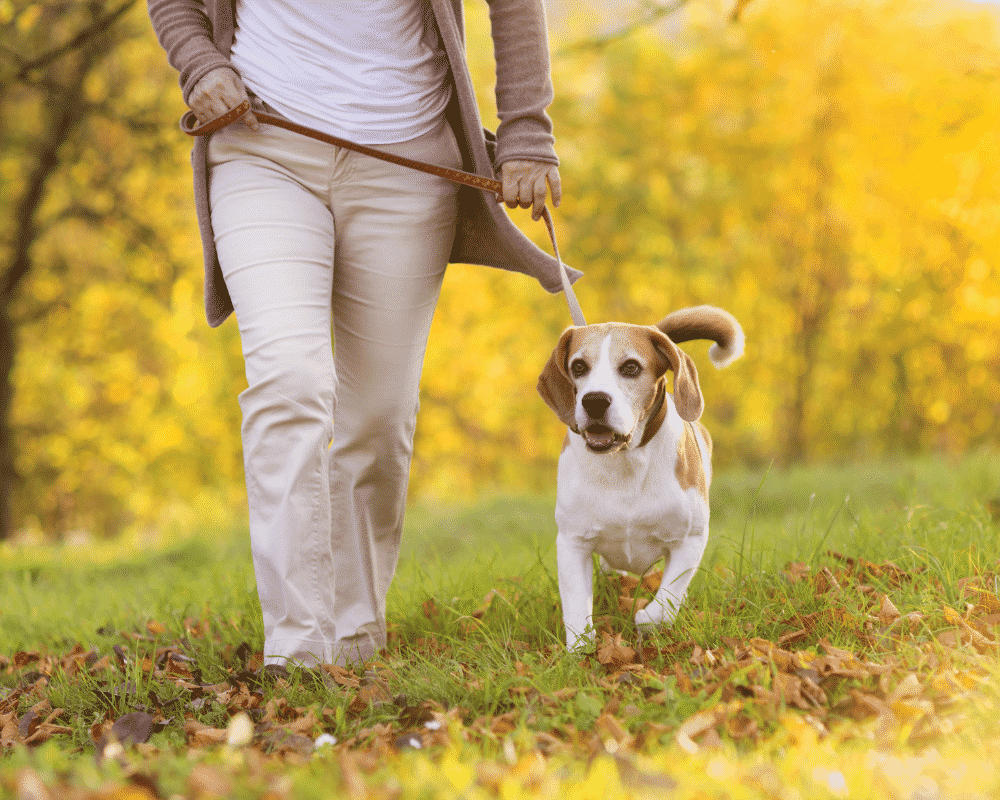Humans need regular exercise to maintain optimal health. By moving our bodies, we strengthen bones and joints, manage weight and chronic conditions such as diabetes and heart disease, and improve immune system and cognitive function. Regular exercise also releases hormones that decrease stress.
Surprise! Our dogs are no different. And just like humans, they come in a variety of shapes and sizes. Because of age, breed and environmental variations, exercise requirements differ from dog to dog.
How Much Exercise Does My Dog Need Each Day?
A good baseline for most canines is one hour of activity per day.
For middle-aged, brachycephalic breeds such as Pugs and Bulldogs, several walks a day for 45-60 minutes cumulatively can be plenty. These dogs have restricted airflow due to their shortened snouts, and more vigorous activity can be harmful to their health, leading to respiratory distress. It’s also best to exercise in cool temperatures as their body heat can rise quickly.
Breeds such as Border Collies are built to sustain high-intensity and a longer duration of activity. These breeds can be active for two or more hours per day, which may include chasing a frisbee, going for a run with their human, practicing flyball and similar activities.
Sighthounds like Whippets and Greyhounds need relatively little exercise to meet their physical and mental needs. Built for speed, they are content with three walks a day, and they thrive when provided a few, safe off-leash opportunities to reach their maximum velocity. They tire easily and aren’t endurance athletes. Many retired sighthounds become excellent apartment-dwelling companions.
How Much Exercise Does a Puppy Need?
Not surprisingly, puppies need more physical activity than most adult or senior pets.
If you have a puppy, you’ve likely experienced the “Zoomies”—that quick sprint around a room or throughout your home. This is evidence of pent-up energy that needs to be expended.
Because of their developing limbs, puppies over four months should be exercised multiple times a day for one to two hours cumulatively. At a very young age, a leashed walk is not needed and is unlikely to be very productive since puppies are so distractable. Although, practicing leash-walking skills and recall exercises, such as “come when called”, constitute physical activity.
Playing with a ball, hide and seek with a toy or treat or playtime with other healthy dogs can be productive. Hiking is also a safe activity you and your pup can enjoy together. New sights, smells and terrain provide lots of opportunities for stimulation. Various muscle groups are utilized which is optimal for injury prevention and building strength. In inclement weather, running the stairs, playing tug-of-war and leveraging puzzle games are activities to enjoy.
How Much Exercise Does My Senior Dog Need?
Older dogs need exercise to maintain muscle mass, control weight and provide enrichment. A good rule of thumb to follow for senior dogs is that they need roughly 30 minutes of exercise per day.
Shorter, slower walks that incorporate hills are very beneficial. Swimming is an ideal exercise for older pets, too. They aren’t as likely to overheat, and the non-weight-bearing exercise is easy on arthritic limbs. It’s important to monitor your pet in the water as exhaustion can occur rapidly; life vests can help maintain buoyancy while allowing your pet to reap the benefits of swimming.
If your senior dog slows down, starts limping or seems otherwise physically stressed, stop exercising and consult your veterinarian.
How Do I Know If My Dog Isn’t Getting Enough Exercise?
Dogs that aren’t receiving enough exercise are relatively easy to identify.
Weight gain, in a general sense, reflects too many calories being consumed and not enough expended. A pet’s ideal weight can be determined by assessing their muscle and body condition. A pet with an abdominal tuck, palpable ribs and an hourglass shape, when seen from above, is at their ideal weight.
AKC breed standards can also be a rough guide as to where your purebred pup should fall on the scale. If your pet is 10% above their ideal weight, they are considered overweight. It’s time to get moving!
Under-exercised dogs can also exhibit a multitude of behavioral problems. Dogs that excessively bark, chew household items or pace around the house may not be receiving enough exercise. Lesions attributed to chronic licking such as lick granulomas on the limbs may be caused by boredom and stress. These lesions can look like red, raised, hairless spots on any or all the legs, especially near the wrists.
Muscle atrophy, or muscle wasting, can be a sign that your pet is too sedentary. Since other metabolic, autoimmune and inflammatory diseases can lead to muscle loss, it’s best to consult your veterinarian if you notice any changes in body condition. It’s also best to check in with the doctor before starting any new exercise routine.
At Pet Butler, we want your pet to feel and be their healthiest and happiest. Free up your time spent doing chores so you can have more quality time with your furry companion. We’ll take care of your dog’s waste removal on a weekly, every other week or monthly basis.

